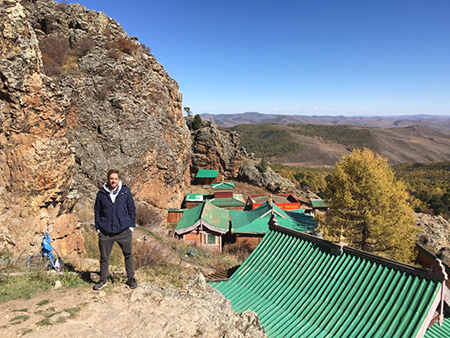Elements of Designing a Video Game
Recently, I had a chance to interview one of the lead technical design architect for the video game Shadow of the Tomb Raider, Mr. Guillaume Monette Martin. He discussed how to design a game and explained what are the important elements of game design. The followings are interview questions and answers which I believe could help readers understand what is involved in designing a game and know more about Guillaume.

Q: What is the most important consideration in designing a game?
A: Before even beginning the design process, you need to first define the ″pillars″ of the game. This will be the foundation of the game development; What will be the main focus, with everything else coming in second. In short, these pillars will give a clearer direction on what should be the development priorities for the whole team.
A good number of pillars is somewhere between 3 and 5. The more pillars, the more work and the harder it will be to make the game feel cohesive between all its mechanics.
Below are several examples of pillars:
Game example: Overcooked:
HARD: The game is meant to challenge the players to the fullest. The experience has to put the players′ skills to the test. Game example: Dark Souls.
CO-OP: Game mechanics have to be made in a way that it′s fun, entertaining and encourage co-op interaction between multiple players. Game example: Overcooked.
Game example: Dark Souls:
EXPLORATION: The environment will be open, filled with rewards for searching everything off the beaten path. The terrain needs to encourage game mechanics like climbing, swimming, maybe even flying, to reach new regions. Game example: Zelda.
COMBAT: Time and effort will be put in to offer diversified enemies. Monsters will have different AI patterns, forcing the player to adapt and use new powerful skills to move forward. Combat needs to feel smooth and responsive while offering enough challenge to entertain players. Game example: Batman Arkham.
This is just a very short list to serve as examples but I highly encourage people to research video game pillars. It′s the best way to start when designing a game.
Q: In what way is psychology used in designing the game, e.g., operant conditioning.
A: As you′ve pointed out, operant conditioning is very important. When teaching a game mechanic to the player, you always want it to be rewarding to encourage him or her to keep using it. Players won′t repeat things that are not rewarding. A simple example would be, If you want them to explore every nook and cranny of your world, you need to hide rewards to be found. A chest that will grant a new weapon, a character that will give a new quest, a portal to a new dungeon, etc. Without rewards, the player will simply stay on the main path like a railroad, until he′s finished with the game.
Another trick is to use human survival instincts. In a dark environment, players will always converge towards light because it feels much safer. This is a very powerful tool to guide the player. Other examples would be things like an oasis in the desert, a big tree on a rainy plain, a waterfall in a fiery forest fire, etc. These are all elements that, depending on the current environment, feel safe thus serves as a sort of directional beacon.
A game that I remember using it cleverly is Left 4 Dead. The players have to navigate a city at night, infested by zombies, so any sign of light would be enticing to them. A sign of life, hinting at the possibility of other non-infested humans, guiding them in the darkness. The designers would have lights showing from windows in the surrounding buildings, luring the players in the direction designed for them to take. Nothing too obvious, but enough to subconsciously guide the players.
Q: Programming and database design are important in designing a game. What other technical skills are required for game design?
A: Having knowledge of various game engines is extremely useful. While they may be different, you′ll quickly notice that there are similarities between each one of them. The more you know, the easier it will become to feel comfortable with any new engine thrown at you. The sad reality of our industry is that each company tends to use their own ″inhouse″ game engine, sometimes even more than one depending on the ongoing projects. This means that you need to be able to quickly assimilate new technology as quickly as possible and any prior experience will definitely hasten that process.
Some engines, for example, Unreal, will have tools like visual scripting to help you achieve your goals more easily without programming skills. Unity, on the other hand, requires C# programming. Some of them will allow you to easily preview animations while others won′t, forcing you to open the files directly from 3D modeling software. In short, all game engines are different so the more you know, the more flexible you′ll be, and the easier it will be to adapt quickly.
Here′s a list of software that I feel are useful to learn:
Unreal – Game Engine
Unity – Game Engine
Perforce – Database sharing
Maya – 3D modeling/animation
Blender – 3D modeling/animation
Photoshop – Image editing/creation
Visual Studio – Programming
You won′t need to know them all but even basic knowledge in some of these tools may open doors for you in the industry.
Q: What is your personal path that led you into game design?
A: The answer to this question is quite simple; I used to play games. A lot. I grew up playing games on the first nintendo (NES) and super nintendo (SNES). My brother and I would play all types of games, from RPGs to actions games, even racing games once in a while. At some point, we discovered the world of MMORPGs (massively multiplayer online role-playing games) and never looked back. I don′t even want to know how much time I′ve sunk in games like Ultima Online and Everquest back in the day. The answer would be: too much!
Now that we′ve settled that I was very passionate about playing video games, what led me to making games. I don′t remember how old I was at the time but I was definitely in elementary school. I really started getting into it when my brother and I discovered the software RPGMaker. This program was meant to be really simple to use and came with visual assets to make it really easy for users to quickly create RPG games on their own. You can even call it a game in itself. I′d spend a lot of time during summer breaks, making little adventures using this tool. It started with some really really terrible games, slowly improving as I′d learn how to use this tool from inside out. When I got older, I started to dabble with Game Maker. A much bigger jump in complexity as this tool could achieve a whole lot more but at the same time, much more difficult to master as it came with nothing to work with as a base. Everything had to be done from scratch but this also came with creative freedom. At some point I started making games with the engine that came with the video game Neverwinter Nights.
While I would never finish any of the game projects I′d start, as you can see I always had this curiosity to dig deeper by starting something new. To try new experiments. To learn new tools. This is what kept me going, eventually leading me to take a one-year associates degree in Level Design that ultimately landed me an internship then a job in the industry.

Q: How important are the visual arts?
A: Art is a big part of making a game. From the very beginning, concept art plays a very important role in deciding the art direction of a game. A cool piece of concept art may be able to sell an idea to the project directors, allowing things to move forward quicker and with a clear understanding of the visual expectation.
Concept art is also very useful when developing levels, objects, characters, etc. The more concept artists you have that come up with quick ″mockups″ the better. I say ″mockups″ but they′re usually a truly beautiful piece of art done by amazing artists. The art gets approved and is then used by the other artists as the number one reference.
3D Modelers are also phenomenal artists and very necessary in developing games nowadays. Games are becoming more and more stunning and beautiful visually. This requires a tremendous amount of work from all of the art team. There are different specialties in modeling, but in short they′re the ones that will digitally sculpt plants to look realistic, create horses that feel and look alive, shape characters with a creative and interesting twist, etc. Everything that you see in games will have been created by a 3D modeler.
You have plenty of other types of artists too. Lighting artists that will use different light sources to bring the best out of sceneries, VFX artists that make little details like dust in the wind stand out or big ″wow″ moments like a volcano erupting. You can even consider acting as part of it too as a lot of the animations you see in-game are first recorded from live actors. Actors are especially important for cinematics that portrays deep emotional moments between various characters.
So yes, visual art is a key part of making games, from beginning to end.
Q: Do you have any advice for youngsters in game playing or who want to design games?
A: Enjoying playing video games and making them are two completely different things. Even if you enjoy playing a game for eight hours straight, it doesn′t necessarily translate to you enjoying working on a game for eight hours straight.
Start your own fun little projects, try, fail, and try again. It doesn′t even matter whether you complete any of these projects because it′s the knowledge you′ll learn from them that′s precious. In this day and age, we′re so lucky to have so many powerful tools out there that are available for free. Use them. Engines like Unity or Unreal have a vast amount of tutorials to teach you how to make your ideas come true.
Don′t be afraid of failure. Try creating all your crazy ideas and whether it fails or succeeds, move on to the next one. Learn to enjoy the process of starting from nothing and building your idea into something cool. You′ll be doing a whole lot of it.
